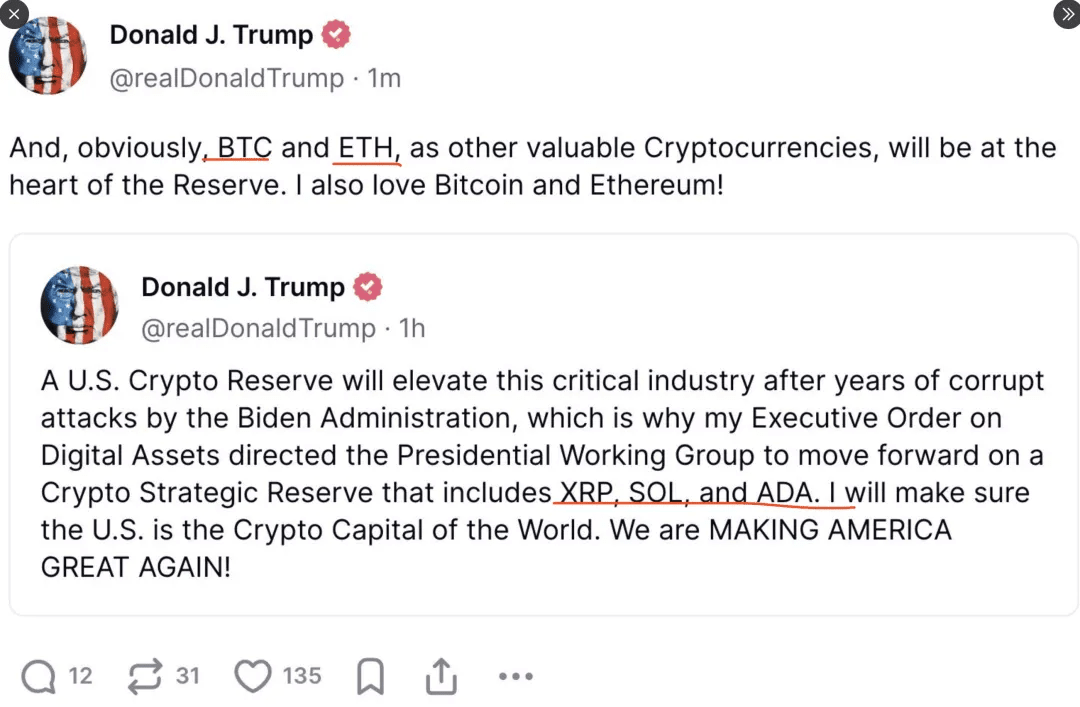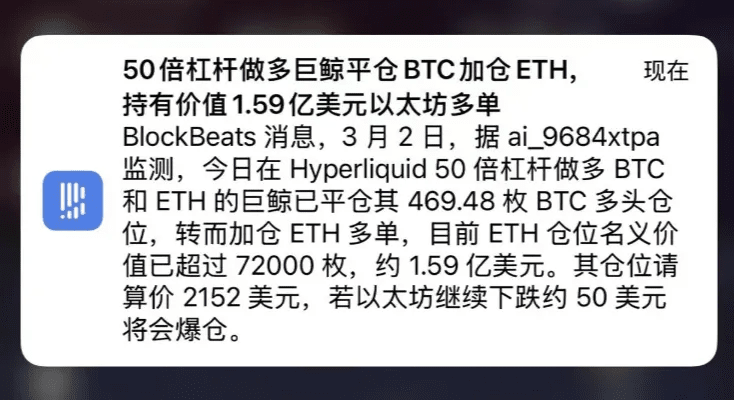
On March 2, 2025, US President Trump released a "nuclear bomb-level" message on social media: announcing the creation of a US strategic cryptocurrency reserve, explicitly including Bitcoin (BTC), Ethereum (ETH), Ripple (XRP), Solana (SOL) and Cardano (ADA). Within just a few hours, the crypto market soared - BTC broke through $93,000, XRP and SOL exploded one after another, and ADA and other currencies rose by more than 70% in a single day, and the total amount of liquidation on the entire network soared to $811 million. This "crypto carnival" led by politicians seems to be Trump's promise to "make the United States the global crypto capital", but in fact it hides a sophisticated calculation of political and business linkage.
Trump's "crypto strategic reserve" did not come out of thin air. As early as the 2024 campaign, his team showed goodwill to crypto voters by issuing personal Meme coin TRUMP and supporting the "World Free Finance" project in a high-profile manner. Now that XRP, SOL and other currencies are included in the reserve, it is even more questioned that there is "precise interest transfer." For example, the SOL and XRP project parties have established political ties by sponsoring Trump's inauguration ceremony and private events at Mar-a-Lago. However, BTC and ETH are only classified as "core reserves" to enhance policy credibility due to strong market consensus. This "name-calling" policy is essentially a conspiracy of political endorsement and capital returns.
This marks that the influence of crypto capital has begun to deeply intervene in the core of US decision-making, and a new era has begun.
The battle to defend the dollar's hegemony: Cryptocurrency becomes a new bargaining chip in geopolitical games
Trump's crypto ambitions are far more than just winning over voters. In recent years, the share of the U.S. dollar in global reserve currencies has continued to decline, and stablecoins (such as USDT and USDC) have unexpectedly become the "digital tentacles" of the U.S. dollar's global penetration by anchoring to the U.S. dollar. Trump's team has keenly captured this trend and tried to include cryptocurrencies in the strategic reserve in the name of the country, both to consolidate the hegemony of the U.S. dollar and to seize the commanding heights of digital finance.
The deeper intention is to divide the opponent camp. During Biden's administration, high-pressure regulation was adopted on the crypto industry, while Trump shouted "End Biden's crypto war" and successfully transformed the crypto community into a political vote bank by withdrawing the lawsuit against Coinbase and appointing pro-crypto regulators. This policy shift is actually to incorporate the crypto industry into the strategic framework of "America First" and reconstruct the global financial discourse power through digital assets.
Market carnival and speculation trap: bloody harvest behind huge gains

Positive policies have ignited market sentiment, but they cannot hide the bloodthirsty nature of capital. Behind the one-day surge in XRP, SOL and other currencies, on-chain data has revealed clues: some whales have liquidated their long positions in advance, suspected of using insider information for arbitrage.
Retail investors became victims in this carnival. Within 24 hours, 176,000 people’s positions were liquidated and $550 million of short orders were wiped out, exposing the fatal fragility of the “policy market” in the crypto market. Trump’s orders are like adding a turbo engine to a casino, which attracts follow-up funds in the short term, but in the long term exacerbates market volatility and systemic risks.
Trump's crypto policy seems to be unstoppable, but in fact, there are undercurrents. He tried to bypass congressional legislation through executive orders (such as the (Digital Asset Executive Order)), but the federal level (Bitcoin Reserve Act) has been difficult due to the bipartisan game, and four Republican states have rejected similar proposals on the grounds of "excessive volatility." This regulatory split between the federal and state governments has led to a surge in compliance costs. Utah and Arizona have accelerated the promotion of local crypto bills, while states such as Montana have firmly resisted.
The attitude of regulators is equally ambiguous. Although the SEC withdrew its lawsuit against Coinbase and redefined the attributes of tokens, the securitization controversy of XRP and other currencies remains unresolved. If Trump fails to be re-elected, the current policy is likely to become a "castle in the air" and even lead to regulatory regression.
The future in the eye of the storm: the ultimate game between the March 7 summit and non-agricultural data
The short-term fate of the market depends on two key events:
1. White House Crypto Summit (March 7): If Trump announces details such as the size of reserves and sources of funds, it may trigger a global "crypto reserve competition"; otherwise, if it becomes just a slogan, the bubble will burst faster.
2. Non-farm data and Fed policy: Weak employment data may strengthen expectations of rate cuts and boost the rise of crypto assets; if the data is strong, the Fed's delay in rate cuts will suppress risk appetite.
In the long run, the essence of this game is the collision between the traditional financial order and the native value of digital. Whether Trump's "strategic reserve" succeeds or fails, it has torn open the cracks in the old system - when the state machine begins to embrace the encrypted world where code is law, the power game between Wall Street and Washington is quietly rewriting the script of monetary history.
The surge in the crypto market is the product of the resonance of political ambition and capital greed. Trump's call is like a stone to test the digital boundaries of the US dollar hegemony. For ordinary investors, this is not only an opportunity to witness history, but also a test to fight against human greed. After all, on the stage where Bitcoin dances with power, the carnival will eventually end, and only those who are sober can cross the cycle and wait for the dawn of the next scene.
Lao Xu reminds us to pay attention to risks and be wary of chasing highs and selling lows.
Refuse to get something for free. If you think you have gained something, please like and share it.
Subscribe to this account to get continuous updates

